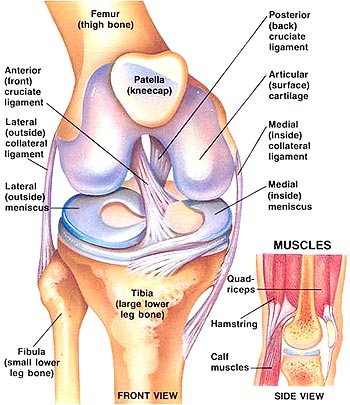There are several types of joints:
Fibrous
These joints are fixed and move minimal amounts.
Sutures are dense fibrous connective tissue found in the skull of babies and are the 'soft spots' on their head. In older age these sutures ossify and become fixed (synostosis). The irregular interlocking edges allow for additional strength and minimise possible fractures.
Syndesmoses joints are found between the articulated surfaces of the tibia and fibula, made up of considerably more fibrous connective tissue than sutures and are united by interosseous ligaments.
Cartilaginous (symphysis and synchondrosis)
Cartilaginous joints have no joint cavity and are held together between cartilage, they allow more movement than in the fibrous joints but less so than synovial.
Symphysis joints such as the pubis symphysis and the external vertebral bodies are made up of broad fibrocartilage
Synchondrosis joints are made up of hyaline cartilage and can be found in epiphyseal plates, found between the first rib and the sternum.
Synovial joints
1. Ball and socket 2. Ellipsoid joint 3. Saddle joint 4. Hinge Joint 5. Pivot Joint
These joints have a joint cavity and are subclassified by their movements, they are also usually accompanied by accessory ligaments which allow two bones of different shapes to tightly fit and stablizes the joint. Inside the joint cavity it contains synovial joint fluid which reduces friction (similar to bursae) it also supplies nutrients and removes metabolic waste and waste formed from wear and tear of cartilage by phagocytes. The articular capsule has two layers; fibrous outter layer and articulated inner layer (formed by synovial membrane). The fibrous layer allows for movement and its tensile strength reduces changes of injury and dislocation.
Ball and socket moves on three planes; rotation, flexion/extension and abduction/adduction.
Hinge joints such as the knee consist of a convex bone surface fitting into a concave bone surface and usually only flex/extend
Saddle joints such as the first carpo-metacarpal joint consist of a saddle shaped articular surface and a concave/complex opposing surface. Flexion/extention, Abduction/Adduction and Circumduction.
Gliding joints such as the patellofemural are flat articulated surfaces which are restricted by ligaments so can only move side to side and back and forth.
Pivot joints can be found in the radioulnar which allow full rotation: pronation and supination.
Ellipsoidal (condyloid) joints such as the wrist joint allow two plane movement (flexion/extention, cirumduction, adduction/abduction)
Hyaline cartilage is a pearly white cartilage which is found at the ends of bones and in your ears and nose, trachea, bronchi and parts of the larynx. It provides smooth surfaces for joints to move without friction, it has a high tensile strength and is avascular so is supplied by surrounding synovial fluid.
Bursaes are fluid filled connective tissue (similar fluid to synovial fluid) which reduce friction in areas of high movement such as the knee joint.
Tendons and Ligaments
A tough band of connective tissue made of collagen fibres, they usually connect muscle to bone at periosteum; very strong and pliable. Tendons do not move at all but ligaments do to accommodate for joint movement. Tendons are inclosed by sheaths to allow them to move back and forward without friction.















0 comments:
Post a Comment